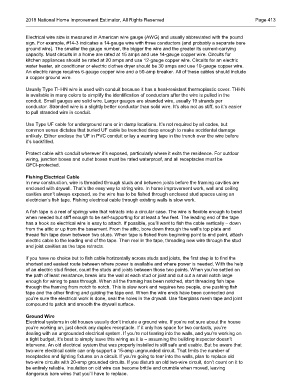Page 518 - 2018 National Home Improvement
P. 518
2018 National Home Improvement Estimator, All Rights Reserved Page 413
Electrical wire size is measured in American wire gauge (AWG) and usually abbreviated with the pound
sign. For example, #14-3 indicates a 14-gauge wire with three conductors (and probably a separate bare
ground wire). The smaller the gauge number, the bigger the wire and the greater its current-carrying
capacity. Most circuits in a home are rated at 15 amps and use 14-gauge copper wire. Circuits for
kitchen appliances should be rated at 20 amps and use 12-gauge copper wire. Circuits for an electric
water heater, air conditioner or electric clothes dryer should be 30 amps and use 10-gauge copper wire.
An electric range requires 6-gauge copper wire and a 50-amp breaker. All of these cables should include
a copper ground wire.
Usually Type THHN wire is used with conduit because it has a heat-resistant thermoplastic cover. THHN
is available in many colors to simplify the identification of conductors after the wire is pulled in the
conduit. Small gauges are solid wire. Larger gauges are stranded wire, usually 19 strands per
conductor. Stranded wire is a slightly better conductor than solid wire. It’s also not as stiff, so it’s easier
to pull stranded wire in conduit.
Use Type UF cable for underground runs or in damp locations. It’s not required by all codes, but
common sense dictates that buried UF cable be trenched deep enough to make accidental damage
unlikely. Either enclose the UF in PVC conduit or lay a warning tape in the trench over the wire before
it’s backfilled.
Protect cable with conduit wherever it’s exposed, particularly where it exits the residence. For outdoor
wiring, junction boxes and outlet boxes must be rated waterproof, and all receptacles must be
GFCI-protected.
Fishing Electrical Cable
In new construction, wire is threaded through studs and between joists before the framing cavities are
enclosed with drywall. That’s the easy way to string wire. In home improvement work, wall and ceiling
cavities aren’t always exposed, so the wire has to be fished through enclosed stud spaces using an
electrician’s fish tape. Fishing electrical cable through existing walls is slow work.
A fish tape is a reel of springy wire that retracts into a circular case. The wire is flexible enough to bend
when needed but stiff enough to be self-supporting for at least a few feet. The leading end of the tape
has a hook so electrical wire is easy to attach. If possible, you’ll want to fish the cable vertically – down
from the attic or up from the basement. From the attic, bore down through the wall’s top plate and
thread fish tape down between two studs. When tape is fished from beginning point to end point, attach
electric cable to the leading end of the tape. Then reel in the tape, threading new wire through the stud
and joist cavities as the tape retracts.
If you have no choice but to fish cable horizontally across studs and joists, the first step is to find the
shortest and easiest route between where power is available and where power is needed. With the help
of an electric stud finder, count the studs and joists between those two points. When you’ve settled on
the path of least resistance, break into the wall at each stud or joist and cut out a small notch large
enough for wiring to pass through. When all the framing has been notched, start threading fish tape
through the framing from notch to notch. This is slow work and requires two people, one pushing fish
tape and the other finding and guiding the tape end. When the wire ends have been connected and
you’re sure the electrical work is done, seal the holes in the drywall. Use fiberglass mesh tape and joint
compound to patch and smooth the drywall surface.
Ground Wire
Electrical systems in old houses usually don’t include a ground wire. If you’re not sure about the house
you’re working on, just check any duplex receptacle. If it only has space for two contacts, you’re
dealing with an ungrounded electrical system. If you’re not tearing into the walls, and you’re working on
a tight budget, it’s best to simply leave this wiring as it is – assuming the building inspector doesn’t
intervene. An old electrical system that was properly installed is still safe and usable. But be aware that
two-wire electrical cable can only support a 15-amp ungrounded circuit. That limits the number of
receptacles and lighting fixtures on a circuit. If you’re going to tear into the walls, plan to replace old
two-wire circuits with 20-amp grounded circuits. If you disturb an old two-wire circuit, don’t count on it to
be entirely reliable. Insulation on old wire can become brittle and crumble when moved, leaving
dangerous bare wires that you’ll have to replace.

